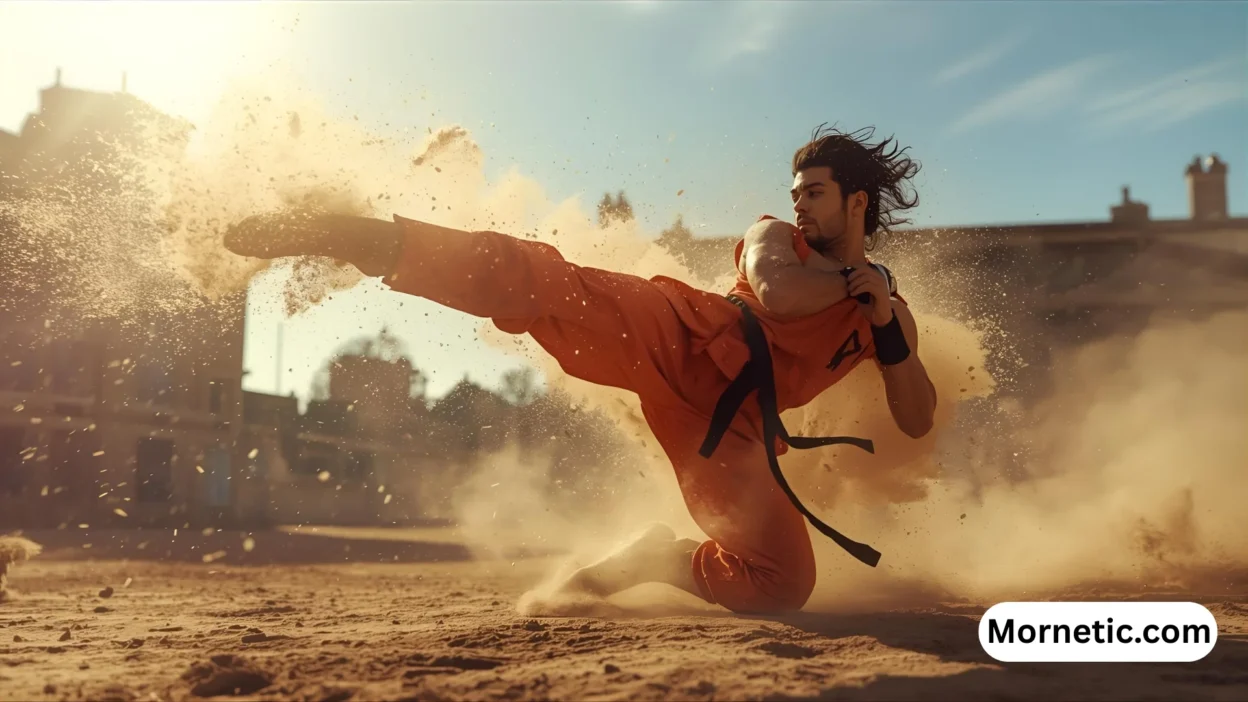That powerful, satisfying thwack of your shin connecting with the bag first thing in the morning is a fantastic way to start your day. The roundhouse kick is a cornerstone of martial arts, celebrated for its power, versatility, and the full-body engagement it requires. Incorporating it into your morning routine can feel invigorating, boosting your energy and mental focus. But are you paying attention to the messages your body is sending? Beyond the adrenaline rush and the sense of accomplishment lies a reality often glossed over in training montages: the potential for side effects.
Understanding these side effects isn’t about discouraging your practice; it’s about empowering you to train smarter, safer, and for the long haul. This comprehensive guide will dive deep into the common, uncommon, and often overlooked side effects of performing roundhouse kicks, especially on a fasted, stiff body first thing in the morning. We’ll equip you with the knowledge to mitigate risks, enhance recovery, and ensure your kicking practice builds you up instead of breaking you down.
What Exactly is a Roundhouse Morning Kick?
Before we analyze the side effects, let’s define our subject. A roundhouse morning kick is simply the execution of a standard roundhouse kick (Mawashi Geri in Karate, Tae Ya Chagi in Taekwondo) as part of a morning training regimen. This could be in a formal dojo setting, a garage gym, or your living room. The “morning” aspect is critical because your body’s physiology is different upon waking. Your muscles are colder, your joints are stiffer, and you may be training in a fasted state, all of which can amplify the potential for negative side effects if not managed correctly.
The Musculoskeletal Side Effects: From Shin Splints to Strains
This is the most common category of issues practitioners face. The immense force generated and absorbed by the kick can take a significant toll on your body’s framework.
- Shin Pain and Micro-Fractures (Shin Splints): 🦵 Your shin bone (
tibia) is the primary weapon for a roundhouse kick. Repeated impact, especially with improper form or a hard bag, can cause inflammation of the muscles and tendons around the shin (shin splints) or, more severely, tiny stress fractures in the bone itself. - Hip Flexor and Groin Strains: The powerful lifting and rotating motion of the kick heavily engages the hip flexors and groin muscles. A cold, tight muscle forced into a dynamic stretch under load is a prime candidate for a painful strain or tear.
- Knee Ligament Stress: Your standing (pivot) leg is the foundation of the kick. If your foot doesn’t pivot correctly or your knee collapses inward, you place immense stress on the
ACL,MCL, and other stabilizing ligaments, risking sprains or more severe injuries. - Ankle Sprains and Instability: The instep of your foot is another common point of contact. Connecting at a wrong angle can lead to a rolled ankle or chronic instability. The ankle of the pivot foot is also vulnerable during the rotation.
- Lower Back Pain: Generating power for a high kick requires core strength. When the core is weak, the lower back often overcompensates, leading to muscle fatigue, stiffness, or even disc-related issues over time.
The Impact of Poor Technique on Side Effects
Poor technique doesn’t just make your kick less effective; it’s the single biggest amplifier of negative side effects. It’s the difference between a precision tool and a blunt instrument.
- Chambering Incorrectly: Failing to properly chamber the knee before extending the kick robs you of power and forces your muscles to work in inefficient, injury-prone ways.
- Lack of Pivot: Not pivoting fully on the ball of your standing foot places tremendous torque on your knee joint, a recipe for a debilitating ligament injury.
- “Armchair” Kicking: Letting your upper body lean back during the kick (
armchairing) compromises your balance, engages your lower back incorrectly, and reduces power. - Poor Re-chambering: Simply dropping your leg after impact instead of snapping it back to the chamber position misses a crucial strengthening phase and can strain the hip joint.
Overtraining and Inadequate Recovery: The Silent Aggravators
In our enthusiasm for progress, we often fall into the trap of “more is better.” With a demanding technique like the roundhouse kick, this is a dangerous assumption.
- Chronic Inflammation: Training too frequently without adequate rest prevents your body from repairing the micro-tears in your muscles and connective tissues. This leads to a state of persistent, low-grade inflammation, manifesting as constant soreness and decreased performance.
- Performance Plateau or Regression: 🚧 Overtraining taxes your central nervous system. You may find your kicks becoming slower, less powerful, and your coordination suffering, despite putting in more hours.
- Increased Injury Risk: A fatigued body is an injury-prone body. Your form deteriorates when you’re tired, significantly increasing the likelihood of acute injuries like strains and sprains.
The Hidden Role of Foot and Ankle Biomechanics
Many practitioners overlook the critical role that foot structure plays in kinetic chain efficiency. Issues like overpronation (flat feet) or supination (high arches) can dramatically alter force distribution from the ground up.
- Overpronation and Knee Valgus: Flat feet can cause the knees to collapse inward (
valgus) during the kick’s pivot, placing extreme stress on theMCLand patella. - Supination and Ankle Sprains: High arches can lead to a less stable base, increasing the risk of ankle rolls upon impact or during the pivot phase.
- Plantar Fasciitis: The repetitive stress on the arch of the pivot foot can inflame the plantar fascia ligament, causing sharp heel pain, especially with those first few steps in the morning.
Morning-Specific Physiological Factors
Your body is not the same machine at 6 AM as it is at 6 PM. Training first thing introduces unique variables that can influence side effects.
- Fasted State Training: 🕗 Training on an empty stomach can enhance fat burning, but it also means your muscle glycogen stores are depleted. This can lead to premature fatigue, causing your form to break down earlier in your session.
- Increased Joint Stiffness: Synovial fluid, which lubricates your joints, is thicker in the morning. This is why you feel stiffer. Launching into high kicks without a proper warm-up is a direct path to joint strain.
- Higher Blood Pressure and Heart Rate: These are naturally elevated in the morning, which can be a consideration for individuals with underlying cardiovascular conditions, making the intense exertion of kicking feel more taxing.
Nutritional Support for Kick Training and Recovery
You can’t fire a cannon from a canoe. Fueling your body correctly is non-negotiable for performance and injury prevention.
- Pre-Training Fuel (Even in the AM): If you feel sluggish, a small, easily digestible carbohydrate-rich snack 30-60 minutes before training (e.g., a banana, a piece of toast) can top off energy stores without causing stomach upset.
- Post-Training Recovery Nutrition: The 30-60 minutes after your workout is the “anabolic window.” Consuming a combination of protein (20-30g) and carbohydrates helps repair muscle tissue and replenish glycogen stores. A protein shake is a convenient morning solution.
- Hydration is Key: 💧 You wake up dehydrated. Drink a large glass of water as soon as you get up and continue sipping throughout your session. Dehydration impairs muscle function and cognitive focus, directly increasing injury risk.
The Essential Warm-Up and Cool-Down Protocol
Skipping your warm-up and cool-down is the fastest way to turn potential side effects into reality. Here’s a targeted routine.
- Dynamic Warm-Up (5-10 minutes): This prepares your body for movement. Never use static stretching when cold.
- Leg swings (forward and side-to-side)
- Hip circles and arm circles
- Torso twists
- Walking lunges (with a twist for dynamism)
- High knees and butt kicks
- Technical Drilling (5 minutes): Start with slow, controlled kicks in the air. Focus on perfect form, chamber, and pivot. Gradually increase speed and height.
- Static Cool-Down (5-10 minutes):After your session, use static stretching to improve flexibility and aid recovery.
- Hold stretches for your hip flexors, hamstrings, quads, groin, and calves.
- Use a foam roller on your quads, IT band, and glutes.
Protective Gear and Equipment Considerations
Using the right gear isn’t a sign of weakness; it’s a mark of intelligence and longevity in the sport.
- Shin Guards: 🛡️ Essential for heavy bag work and partner drilling. They distribute impact and protect the delicate tibia from direct trauma.
- Instep Pads: Protect the top of your foot from abrasions and impact injuries.
- Quality Footwear (if applicable): If you train in shoes, ensure they provide good lateral support and a sole that allows for pivoting.
- Heavy Bag Quality: A modern, well-filled heavy bag is far more forgiving on your bones and joints than an old, stiff, sand-filled bag.
The Psychological and Neurological Side Effects
It’s not all physical. The repetitive, high-skill nature of kicking has mental ramifications.
- Frustration and Mental Burnout: The learning curve for a powerful, technically sound roundhouse kick is steep. Plateaus can lead to significant frustration and demotivation.
- Hyper-Vigilance and Fear of Injury: After experiencing a painful side effect like a shin bruise, you may develop a subconscious flinch or hesitation, preventing you from committing fully to the technique.
- Improved Mind-Body Connection: ✅ On the positive side, consistent practice dramatically enhances your proprioception (awareness of your body in space), coordination, and cognitive focus, benefits that translate to all areas of life.
Long-Term Implications for Joint Health
This is the big question: what does a lifetime of kicking do to your joints? The answer is highly dependent on your approach.
- With Proper Technique and Recovery: Practitioners can maintain healthy, strong joints for decades. The movement, when done correctly, strengthens the supporting musculature, creating more stable joints.
- With Poor Technique and Overtraining: The cumulative effect of improper force distribution leads to premature wear-and-tear
osteoarthritisin the hips, knees, and ankles. This is characterized by pain, stiffness, and loss of mobility.
Mitigation Strategies: How to Practice Safely Every Day
Knowledge is useless without action. Here is your actionable plan to minimize roundhouse morning kick side effects.
- Prioritize Form Over Power: Always. Speed and power are products of perfect technique, not the other way around. Film yourself to check your form.
- Listen to Your Body – Differentiate Pain from Discomfort: Muscle fatigue is discomfort. A sharp, stabbing, or radiating pain is a signal to STOP IMMEDIATELY.
- Incorporate Cross-Training: 🏋️ Strengthen the muscles that support the kick. Focus on compound lifts like squats and deadlifts, as well as targeted work for your glutes, core, and hip abductors.
- Get Adequate Sleep: Your body does the majority of its repair while you sleep. 7-9 hours of quality sleep is non-negotiable for recovery.
- Schedule Deload Weeks: Every 6-8 weeks, reduce your training volume and intensity by 40-50% for a week to allow for supercompensation and full systemic recovery.
When to Seek Professional Medical Advice
Self-management has its limits. Consult a healthcare professional if you experience any of the following:
- Joint Pain that Persists for more than a few days or wakes you up at night.
- Any “Popping” or “Giving Way” Sensation in your knee or ankle during the kick.
- Numbness, Tingling, or Radiating Pain down your leg (could indicate nerve involvement).
- Visible Swelling or Deformity in a joint or limb.
- Pain that does not improve with rest and over-the-counter anti-inflammatories.
Frequently Asked Questions (FAQ) About Roundhouse Kick Side Effects
Q1: Is it normal for my shins to hurt after roundhouse kicks?
A: Some muscle soreness is normal, but sharp bone pain is not. Generalized soreness on the front of the shin is common as the tibialis anterior muscle strengthens. However, a sharp, localized pain on the bone itself could indicate a stress fracture and requires immediate rest and medical evaluation.
Q2: How can I strengthen my shins to prevent pain?
A: You can strengthen the muscles around the shin by doing tibialis raises (dorsiflexion against resistance), walking on your heels, and gently tapping the shin along the muscle (not the bone) with a foam roller to improve blood flow.
Q3: What’s the biggest mistake beginners make that leads to side effects?
A: The most common and dangerous mistake is sacrificing form for height or power. Kicking higher than your current flexibility allows or trying to hit the bag as hard as possible without proper technique guarantees that you will develop negative side effects, often in the lower back, hips, or knees.
Q4: Can I still do roundhouse kicks if I have bad knees?
A: This depends on the cause and severity. You must consult with a doctor or physical therapist. They may approve low-impact, technique-focused drills that avoid full pivot or powerful impact, but self-prescribing with a pre-existing condition is highly risky.

Grace is a lifestyle writer from California who loves starting mornings with positivity. At Mornetic, she shares uplifting quotes and cheerful messages to brighten your day.




